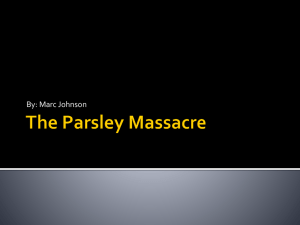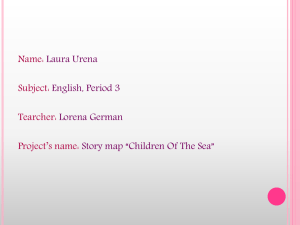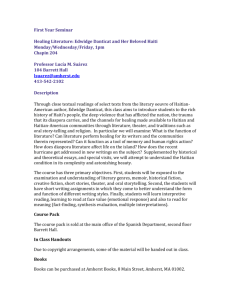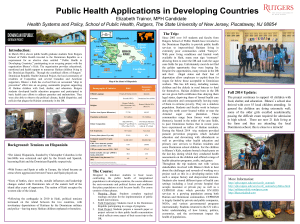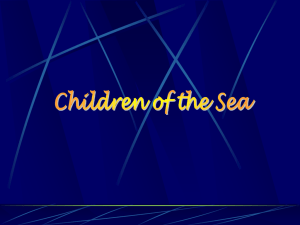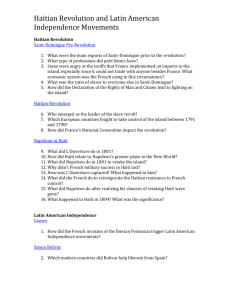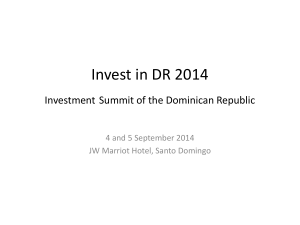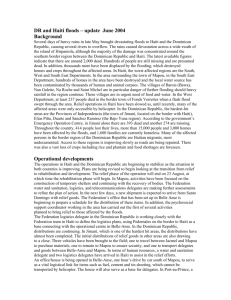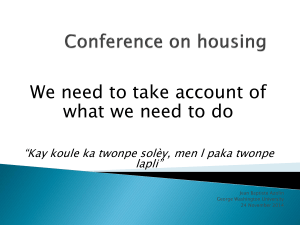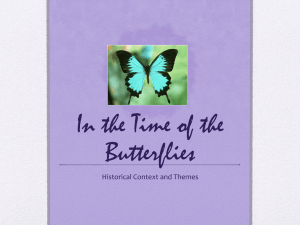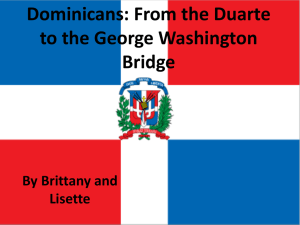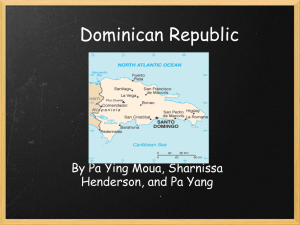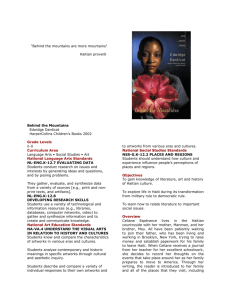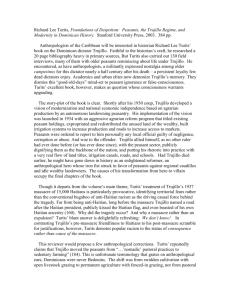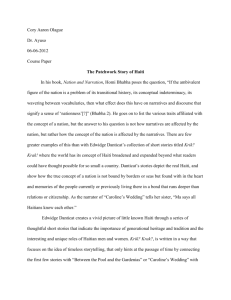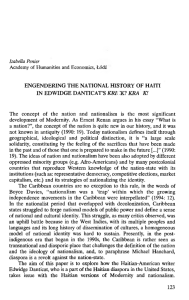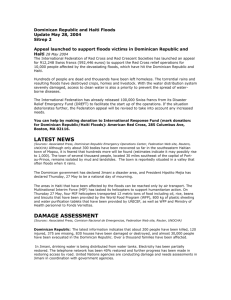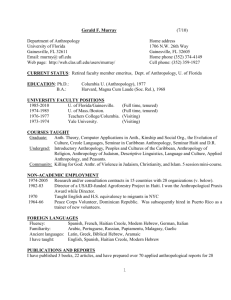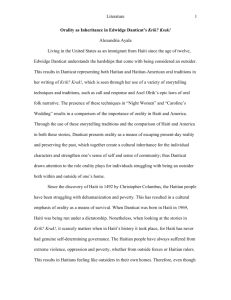Group Research Project - Directions and Requirements
advertisement
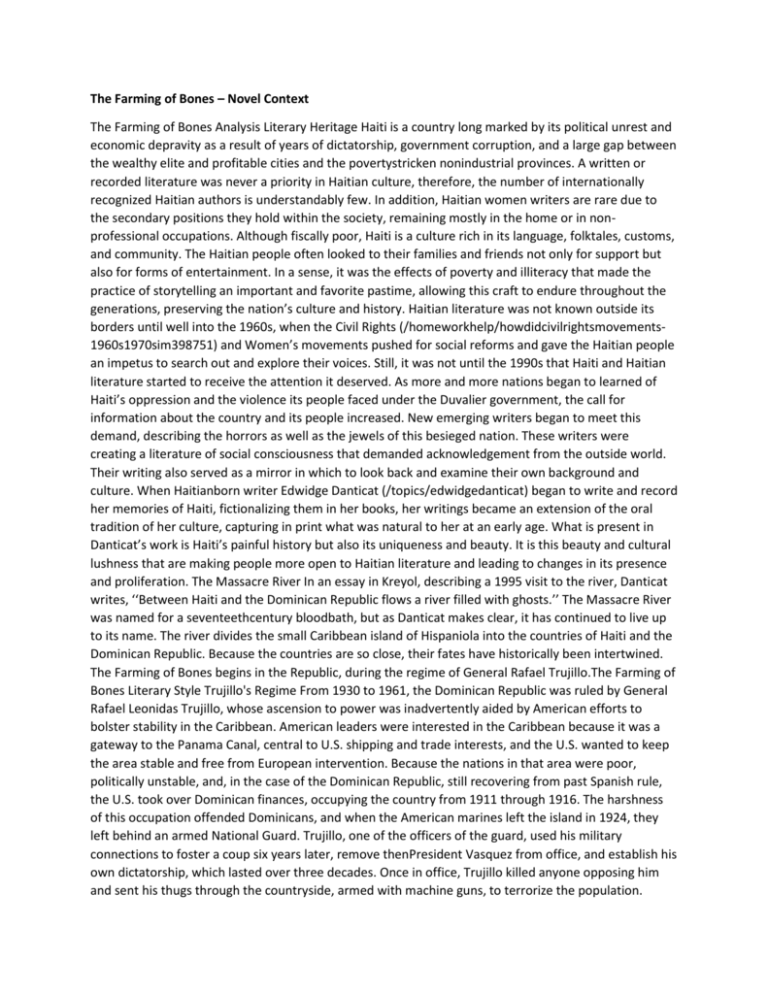
The Farming of Bones – Novel Context The Farming of Bones Analysis Literary Heritage Haiti is a country long marked by its political unrest and economic depravity as a result of years of dictatorship, government corruption, and a large gap between the wealthy elite and profitable cities and the povertystricken nonindustrial provinces. A written or recorded literature was never a priority in Haitian culture, therefore, the number of internationally recognized Haitian authors is understandably few. In addition, Haitian women writers are rare due to the secondary positions they hold within the society, remaining mostly in the home or in nonprofessional occupations. Although fiscally poor, Haiti is a culture rich in its language, folktales, customs, and community. The Haitian people often looked to their families and friends not only for support but also for forms of entertainment. In a sense, it was the effects of poverty and illiteracy that made the practice of storytelling an important and favorite pastime, allowing this craft to endure throughout the generations, preserving the nation’s culture and history. Haitian literature was not known outside its borders until well into the 1960s, when the Civil Rights (/homeworkhelp/howdidcivilrightsmovements1960s1970sim398751) and Women’s movements pushed for social reforms and gave the Haitian people an impetus to search out and explore their voices. Still, it was not until the 1990s that Haiti and Haitian literature started to receive the attention it deserved. As more and more nations began to learned of Haiti’s oppression and the violence its people faced under the Duvalier government, the call for information about the country and its people increased. New emerging writers began to meet this demand, describing the horrors as well as the jewels of this besieged nation. These writers were creating a literature of social consciousness that demanded acknowledgement from the outside world. Their writing also served as a mirror in which to look back and examine their own background and culture. When Haitianborn writer Edwidge Danticat (/topics/edwidgedanticat) began to write and record her memories of Haiti, fictionalizing them in her books, her writings became an extension of the oral tradition of her culture, capturing in print what was natural to her at an early age. What is present in Danticat’s work is Haiti’s painful history but also its uniqueness and beauty. It is this beauty and cultural lushness that are making people more open to Haitian literature and leading to changes in its presence and proliferation. The Massacre River In an essay in Kreyol, describing a 1995 visit to the river, Danticat writes, ‘‘Between Haiti and the Dominican Republic flows a river filled with ghosts.’’ The Massacre River was named for a seventeethcentury bloodbath, but as Danticat makes clear, it has continued to live up to its name. The river divides the small Caribbean island of Hispaniola into the countries of Haiti and the Dominican Republic. Because the countries are so close, their fates have historically been intertwined. The Farming of Bones begins in the Republic, during the regime of General Rafael Trujillo.The Farming of Bones Literary Style Trujillo's Regime From 1930 to 1961, the Dominican Republic was ruled by General Rafael Leonidas Trujillo, whose ascension to power was inadvertently aided by American efforts to bolster stability in the Caribbean. American leaders were interested in the Caribbean because it was a gateway to the Panama Canal, central to U.S. shipping and trade interests, and the U.S. wanted to keep the area stable and free from European intervention. Because the nations in that area were poor, politically unstable, and, in the case of the Dominican Republic, still recovering from past Spanish rule, the U.S. took over Dominican finances, occupying the country from 1911 through 1916. The harshness of this occupation offended Dominicans, and when the American marines left the island in 1924, they left behind an armed National Guard. Trujillo, one of the officers of the guard, used his military connections to foster a coup six years later, remove thenPresident Vasquez from office, and establish his own dictatorship, which lasted over three decades. Once in office, Trujillo killed anyone opposing him and sent his thugs through the countryside, armed with machine guns, to terrorize the population. Money and ownership of land was funneled to him, resulting in widespread poverty and uprooting of entire communities. Mail was censored, telephones were monitored, and citizens needed government permission to move or practice any profession. In 1931, a devastating hurricane struck Haiti and the Dominican Republic, killing 2,000 people and injuring many more. Trujillo used the destruction to his advantage, taking absolute power in the crisis and controlling all medicine and building supplies. He imposed ‘‘emergency’’ taxes, never repealed. Naturally, resentment against him grew, and he murdered, tortured, or imprisoned anyone he suspected of disloyalty. During this period, many Haitians crossed the border into the Dominican Republic, seeking work in the wake of the devastating hurricane. Their sheer numbers began to make some Dominicans uneasy, and there was a racist tone to this unease. As the book notes, Dominicans were told, ‘‘Our motherland is Spain, theirs is darkest Africa, you understand? They once came here only to cut sugarcane, but now there are more of them than there will ever be cane to cut, you understand? Our problem is one of dominion.… Those of us who love our country are taking measures to keep it our own.’’ Trujillo Orders Genocide In 1937, to stop this tide of humanity and implement these ‘‘measures,’’ Dominican troops killed between 10,000 and 15,000 Haitians. As Scott Adlerberg remarked in the Richmond Review, ‘‘None of those killed is anyone famous, nearly all the slaughtered are poor Haitians working as cheap labor in the neighboring country.’’ Danticat also notes that there is often no difference in color between the two sides, despite the insistence that ‘‘our motherland is Spain, theirs is darkest Africa.’’ Language is the only differentiating feature, and Dominican troops use the Haitians' inability to pronounce the trilled Spanish ‘‘r’’ in perejil, the word for parsley. ‘‘Que diga perejil,’’ the soldiers demanded, and anyone who answered ‘‘pewejil’’ would be shot as a Haitian.
